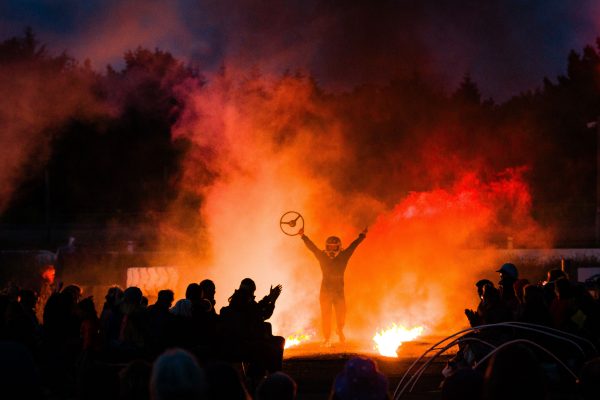…Brave
We talk and think about risk a lot when we’re making new performance work. We rarely encounter physical danger in the way that front-line services do.
Medical staff, care-workers, police, all face statistically much heavier risks, especially during the current crisis. WildWorkers often work in challenging locations, with steep slopes, slippery underfoot, using fire, in the dark, in all weathers – the subject of laboriously crafted risk assessments. But nothing as fiercely hard as trying to keep someone alive while risking your own health and the health of the people you love; we don’t have to muster that kind of bravery.
Yet I have experienced moments of fear in my work…
In the West Bank as part of the Palestine Literature Festival, Bill, Mercedes and I walked down a deserted street in Hebron. We were among a large group of Palestinians and artists of many nationalities. Suddenly we were surrounded and challenged by heavily armed soldiers. This was a forbidden street. ‘WHO ARE YOU? WHERE ARE YOU FROM?’ There was a beat of silence while the implications for the Palestinians among us flashed through our minds. Henning Mankell, the magisterial Swedish writer, spoke. ‘We are from the world’ he said. A true artist’s response. There was a confused pause. Then they allowed us to pass. Creativity and unity saved us.
With Kneehigh back in the 90s we made a splendid little show that toured village halls in Cornwall and Dorset, ‘Telling Tales’. Miraculously it was booked to play the Arts Alive Festival in Soweto. In the weeks before we embarked the stories told to us magnified all kinds of night terrors – carjackings, rapes, murderous burglaries and muggings. A lawless and inhumane place. But guess what? I have never in my life been showered with more love and sheer human affection than we were given on the streets of Soweto.
In the Naval Dockyard in Plymouth we made ‘The Beautiful Journey’, set in the future after all the bees had gone. I played Kassandra, the scientist, scanning the climate and the horizon. I conceived the image of her flying above the dock, suspended from a crane to do her work, Bill loved the idea. But I hadn’t really thought this through. You see, I’m not very good at heights. My brother Pete designed the cage I was to travel in and he was the crane master controlling my voyages. As the moment of my first flight approached I felt physically sick, but there was no way I was going to back out. Pete did a beautiful thing. He showed me around the cage and the crane. He showed me how the cage door was secured and how to open it quickly if I needed to get out in the water. He showed me the strops that attached the cage to the crane hook, two of them as a failsafe. And then I had my first flight, spiralling gently upwards over the dock. Those launches into the sky became my favourite memories of that show, lifted up into the last rays of the setting sun, repeating the mantra of Met Office sea areas ‘Viking, Forties, Cromarty, Forth, Tyne, Dogger, Fisher, German Bight…’, the midnight sound of our Dad’s boat.
Each of these terrors had their cure in love and in other people.




